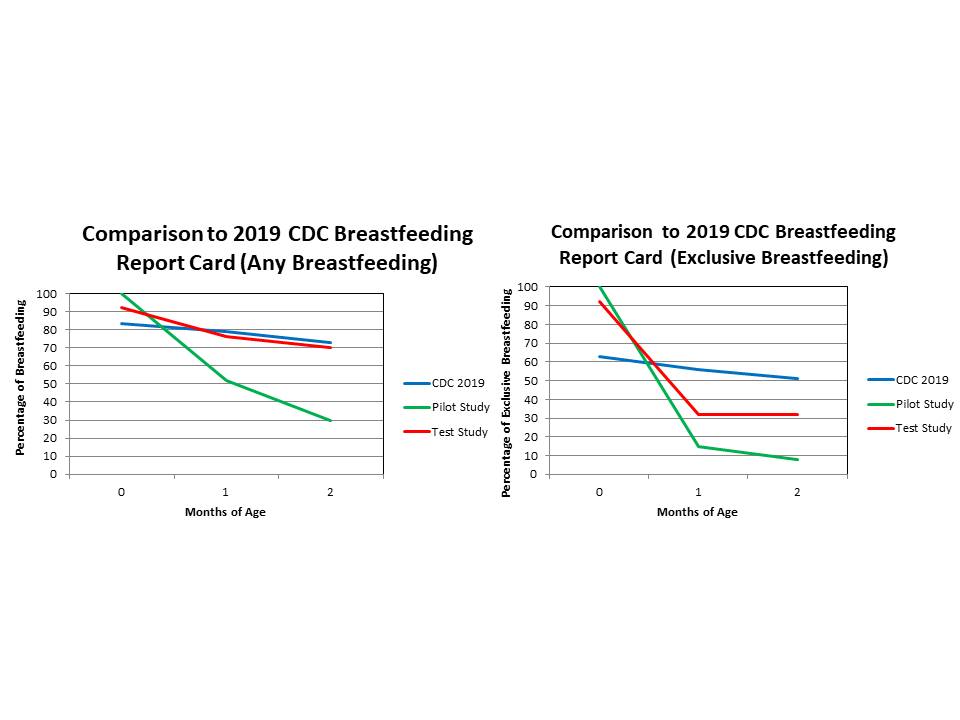Background: Breastfeeding and human milk are the normative standards for infant feeding and nutrition. Studies have shown that newborns who were exclusively breastfed had lower risk of otitis media, upper respiratory tract infections, lower respiratory tract infections, asthma, atopic dermatitis, gastroenteritis, RSV bronchiolitis, obesity, celiac disease, type I and type II diabetes, and leukemia.1,2The American Academy of Pediatrics recommends at least 6 months of exclusive breastfeeding. The CDC issues a report card every 2 years in efforts to monitor breastfeeding rates across the country and find disparities. In the US, a steady decline in any breastfeeding and exclusive breastfeeding from month-to-month indicates that breastfeeding families may need stronger systems of support to reach their breastfeeding goals.3 Wyckoff Heights Medical Center is one of 26 baby-friendly hospital in NYC. As a baby-friendly hospital, we utilize the “Ten Steps to Successful Breastfeeding” based on evidenced-based protocols followed by the AAP, The World Health Organization, The American College of Obstetricians and Gynecologists, The American Academy of Family Physicians, UNICEF/World Health Organization. This protocol is easily accessible on our web portal page.4
Methods: We collected pilot data from inpatient nursery to outpatient clinic from birth to 2 months of age via IRB approved surveys. These determined our pilot data rates based on current hospital practices based on the “Ten Steps to Successful Breastfeeding.” We then attached list of benefits and resources from evidence-based findings/ recommendations of Lactation Specialist, Diana Vientos to Healthy Steps Packets given at newborn, 1 month, 2 month well child visits. We provided an in-service to Pediatric Residents, inpatient and outpatient nursing staff, Nurse Practitioners, House Officers, support staff on continued enforcement of techniques and benefits of breastfeeding through pamphlet. We collected information from 1 cycle (2 Months) through 2 months of life to assess current feeding status after intervention.
Results: Using Two Sample T-Test with Unequal Variances: 1 Month WCV Any breastfeeding: Pilot: 52%; Intervention: 77%; p-value 0.0142 Month WCV Any Breastfeeding: Pilot: 30%; intervention: 70%; p-value 0.000122 Month WCV Exclusive Breastfeeding: Pilot: 8%; Intervention: 32%; p-value 0.0172
Conclusions: Due to WHMC being a baby-friendly hospital, current protocol enforces initial breastfeeding for all mothers. This resulted in high initial breastfeeding records at birth. However, this rate quickly declines at the time of newborn visits within 1 week of life. We found a continued decline of about 70% of mothers doing any breastfeeding throughout the first 2 months of age. More so with mothers continuing to exclusively breastfeed, which saw a decline of over 92% at 2 months of age. WHMC was greatly below national averages for breastfeeding despite current efforts. Through our interventions, we were able to significantly improve breastfeeding rates in newborns between 1 month of age and 2 month of age. We still remain below national levels, but we were able to improve continued breastfeeding rates through 2 months of age. Through our survey and collection of personal narratives, we found the most common barriers to initiate and continue breastfeeding in mothers in our community. We can use these findings to better address specific concerns and target problems that mothers in our community have in order to encourage continued breastfeeding.


